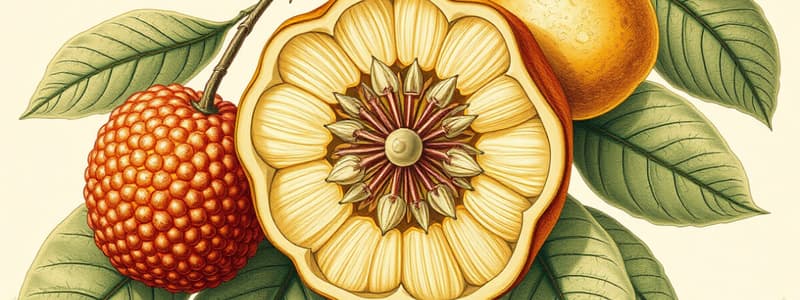Podcast
Questions and Answers
What is the meaning of fruit in botanical terms?
What is the meaning of fruit in botanical terms?
A fruit is the structure that develops from the matured ovary after fertilization and contains the seed.
Name two types of simple fruits and provide a brief description of each.
Name two types of simple fruits and provide a brief description of each.
Dry fruits, which have a hard, woody pericarp, and fleshy fruits, which have a soft pericarp.
What distinguishes aggregate fruits from multiple fruits?
What distinguishes aggregate fruits from multiple fruits?
Aggregate fruits are formed from one flower with an apocarpous pistil, whereas multiple fruits come from many flowers whose ovaries unite.
Define dry dehiscent fruits and give an example.
Define dry dehiscent fruits and give an example.
What are dry indehiscent fruits, and how are they classified?
What are dry indehiscent fruits, and how are they classified?
Explain the structure of a typical fruit's pericarp.
Explain the structure of a typical fruit's pericarp.
Why is the classification of fruits important in botany?
Why is the classification of fruits important in botany?
Provide an example of a fleshy fruit and describe its features.
Provide an example of a fleshy fruit and describe its features.
What is a caryopsis, and provide two examples of fruits that fit this classification?
What is a caryopsis, and provide two examples of fruits that fit this classification?
Differentiate between a cypsela and a nut, mentioning key characteristics of each.
Differentiate between a cypsela and a nut, mentioning key characteristics of each.
Define drupe and provide two examples of fruits classified as drupes.
Define drupe and provide two examples of fruits classified as drupes.
What makes a pome distinct from other fruit types, and give two examples of pomes?
What makes a pome distinct from other fruit types, and give two examples of pomes?
Compare and contrast the structure of a drupe and a berry.
Compare and contrast the structure of a drupe and a berry.
Explain what a hesperidium is and provide an example of a fruit that falls under this category.
Explain what a hesperidium is and provide an example of a fruit that falls under this category.
Identify and describe the major difference between fruit and seed.
Identify and describe the major difference between fruit and seed.
What is a samara, and how does its structure differ from that of a nut?
What is a samara, and how does its structure differ from that of a nut?
Flashcards are hidden until you start studying
Study Notes
Meaning of Fruit
- Develops from the matured ovary after fertilization.
- Contains seeds; parthenocarpic fruits do not develop from fertilized ovaries.
- Composed of pericarp, which includes epicarp, mesocarp, and endocarp.
Types of Fruits
- Classified by origin or structure:
- True and false fruit.
- Simple, aggregate, and composite (multiple) fruits.
- Fleshy and dry fruits.
- Dehiscent and indehiscent fruits.
Simple Fruits
- Formed from one flower with either a monocarpous or syncarpous pistil.
Aggregate and Composite Fruits
- Aggregate fruits originate from one flower with an apocarpous pistil.
- Composite (multiple) fruits come from several flowers; ovaries unite post-fertilization (e.g., pineapple, breadfruit).
Dry Fruits
- Pericarp dries, becoming hard, woody, or fibrous upon ripening.
- Divided into dehiscent and indehiscent.
Dry Dehiscent Fruits
- Split open to release seeds; types include:
- Follicle: splits along one side (e.g., kola).
- Legume: splits along two sides (e.g., cowpea, beans).
- Capsule: splits along two or more lines (e.g., okra, cotton).
- Schizocarps: break into one-seeded parts called mericarp (e.g., Mimosapudica).
- Siliqua: long capsule with two chambers, dehisces by sutures (e.g., Teconia).
Dry Indehiscient Fruits
- Do not split to release seeds; types include:
- Achene: contains one seed (e.g., sunflower, rose).
- Caryopsis: fused pericarp and seed (e.g., rice, maize).
- Cypsela: one-seeded, hairy pappus (e.g., Tridax).
- Nut: hard pericarp (e.g., cashew, walnut).
- Samara: pericarp forms wings (e.g., Combretum).
Fleshy Fruits
- Juicy and succulent; usually indehiscent; store water and carbohydrates.
- Main types include:
- Drupe: pericarp includes thin epicarp, fleshy mesocarp, and hard stony endocarp (e.g., mango, coconut).
- Berry: fleshy mass with non-stony endocarp (e.g., guava, banana).
- Pome: simple false fruit; outer covering from receptacle swelling (e.g., apple, pear).
- Hesperidium: chambers separated by endocarp membranes (e.g., orange).
Differences Between Fruit and Seed
- Fruit forms from ovary, seed from ovule.
- Fruit has two scars (style/stigma remnant, attachment to receptacle); seed has one scar (placenta attachment).
- Fruit contains seeds, seed consists of an embryo.
- Fruit features pericarp; seed has testa.
Differences Between Drupe and Berry
- Drupe has a hard endocarp, while berry has a fleshy endocarp.
- Entire drupe not typically eaten; entire berry is consumed.
Studying That Suits You
Use AI to generate personalized quizzes and flashcards to suit your learning preferences.




